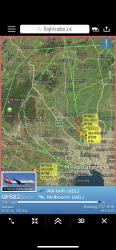Doesn’t Delta wings need high angle of attack at low speed to maintain lift, but this comes at increased drag - which fits in with what
@straitman observes?
In many ways, a delta is simply a normal swept wing, given an extreme angle of sweep.
Sweep angle on airliners is in the mid thirty degrees area. As you increase the sweep, you delay compressibility effects (transonic), and so allow for faster cruise speeds. At the same time though, you decrease the amount of lift gained for any given angle of attack change, and increase the structural issues. If you aren't going any faster than .9 mach or so, there is no point in having a wing designed for mach 1.2.
Delta configurations basically start at about 45º of sweep, and move up from there. The Mirage was, if I recall correctly, 60º, and the A4 was 45º. They have a lot of wing area compared to their span (which means more space for fuel, and a better wing loading). Structurally, they are exceptionally strong.
Downside really just goes with the sweep. Again, you need more pitch change for a given AoA change. Their stalling characteristics are gentle...in fact they may not have a classic stall, but rather keep letting you get more and more AoA, whilst giving decreasing amounts of lift, and more drag. That's not necessarily a bad thing in a fighter, but undesirable in a civilian aircraft.
Landing speeds are not necessarily all that high, just because they are delta. There's a huge difference between tailed, and tail-less use. In an aircraft with a conventional tail (or a canard for that matter), the wing can have the usual high lift devices (slats, flaps), which will allow lower speed operation. But, in a tail-less configuration, the use of such devices is restricted, as the trailing edge of the wing will carry the control surfaces for roll and pitch...and any use equating to flaps would give a pitch input. So, whilst the Mirage, with no high lift devices at all, had an approach speed of around 180 knots, the A4, with slats and flaps, was back around 125 knots.
Another issue that will affect landing speeds is geometry. You don't want the nose so high that the pilot cannot see the runway.....and you also need to avoid tail strike. Both issues give a practical maximum to the pitch angle for the approach and landing....and for a given pitch angle, there will be a corresponding AoA/speed.
There is a bit of discussion about sweep angle here:
What is the optimal wing sweep angle for a passenger airliner?
















